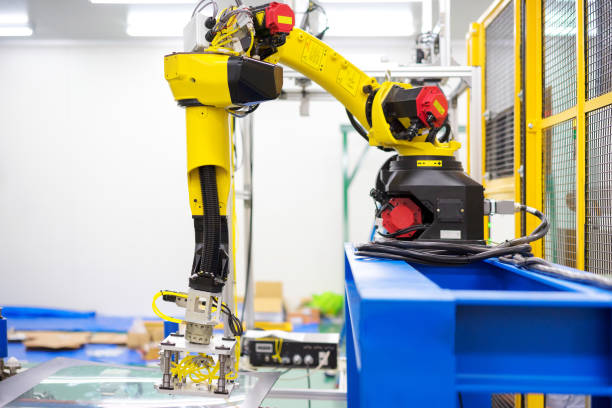Glass Handling Robot
Glass handling robots offer unmatched precision and safety in the flat glass industry. Their precise transfer of spacer frames coated with butyl to the IG line improves production quality and efficiency, contributing towards overall production success.
Multiple sensors work in concert with motors to achieve accurate and stable operation of this robotic structure, which features lightweight material with high stiffness design. Furthermore, bionic end-suction technology was utilized by its end effector in order to more securely grasp glass substrate.

From Factory to Future
Glass handling robots play a critical role in modern industry, enabling manufacturers to produce glass products more quickly and safely while cutting labor costs and improving the quality of their product. This technology also enables companies to reduce labor expenses while raising overall product standards.
Increased automation in manufacturing and demand for precise handling solutions have contributed to the rapid expansion of the glass handling robot market. Furthermore, robust construction and glazing sectors have increased demand for these machines, while technological innovations and expansion of e-commerce logistics continue to fuel its development.
Glass handling robots have become an indispensable component in consumer electronics assembly lines, helping assemble mobile phones, tablets, and television screens with precision and safety. These machines can take the place of human workers when handling large delicate panels with great accuracy – assuring correct components are in their proper places and helping ensure proper alignment for screens on these electronic devices. They perform complex tasks that would otherwise be unsuited for human hands to do effectively.
Industry 4.0
Industry 4.0 refers to a trend marked by digitization and connection of industrial value chains, as can be observed in glass manufacturing and processing industries. By employing modern technologies like robots, sensors and automation in these sectors, manual labor costs and operational costs are reduced while efficiency increases substantially.
An increased focus on workplace safety has also played a key role in driving this market forward, driving adoption of robotic systems which help businesses meet workplace safety standards while cutting liability costs.
Glass handling robots have also seen widespread application in consumer electronics manufacturing. Assembly of electronic devices such as smartphones, tablets, and television screens requires precise manipulation of delicate glass components – which robots help ensure don’t break during assembly process – helping prevent damage while guaranteeing accurate alignment during the assembly process. Their market is expected to see continued growth as costs associated with purchasing them continue decreasing.
Automation
Glass-handling robots simplify processes across industries that rely on glass components. From installing large-scale glass facades for construction projects to transporting solar panels for production, these automated solutions help streamline processes while cutting operational costs and improving safety by replacing manual labor with advanced automation technology.
Specialized gripping systems adapt flexibly to different glass specifications for secure and damage-free handling. A smart pressure regulation system determines the appropriate force level needed to apply; sensors then select an optimal contact pressure level according to each glass size.
This system ensures glass can be safely loaded and unloaded onto insulating glass lines without error, providing consistent quality of finished products. Furthermore, frame setting in an IG line helps ensure frames are correctly positioned prior to butyl coating and tempering processes.
Automation afforded by glass-handling robots can also reduce injuries associated with manually handling glass panes. Furthermore, they make workers more productive by eliminating breaks and creating an enjoyable work environment.
Artificial Intelligence
By employing AI and machine learning, glass handling robots are capable of quickly adapting to new tasks without much human intervention, handling glass of various shapes and sizes more efficiently while improving productivity and lowering costs.
Glass-handling robots provide automotive industry manufacturers with precise positioning of windows, windshields and sunroofs during vehicle production – improving quality and efficiency while creating architectural glass pieces with precision that meets industry standards. They also help architectural glass artists produce intricate designs while meeting industry specifications.
Glass-handling robots can also be found in logistics and warehousing settings, helping organize finished glass products for storage or shipment efficiently. In addition, these robotic devices can carry heavy loads that would be unsafe or challenging for humans to carry safely.
As with any machine, glass-working robots require regular servicing and maintenance – although maintenance costs tend to be far less than manual labour costs. Furthermore, robots can work for long hours without becoming fatigued while humans must take breaks periodically during operation.
